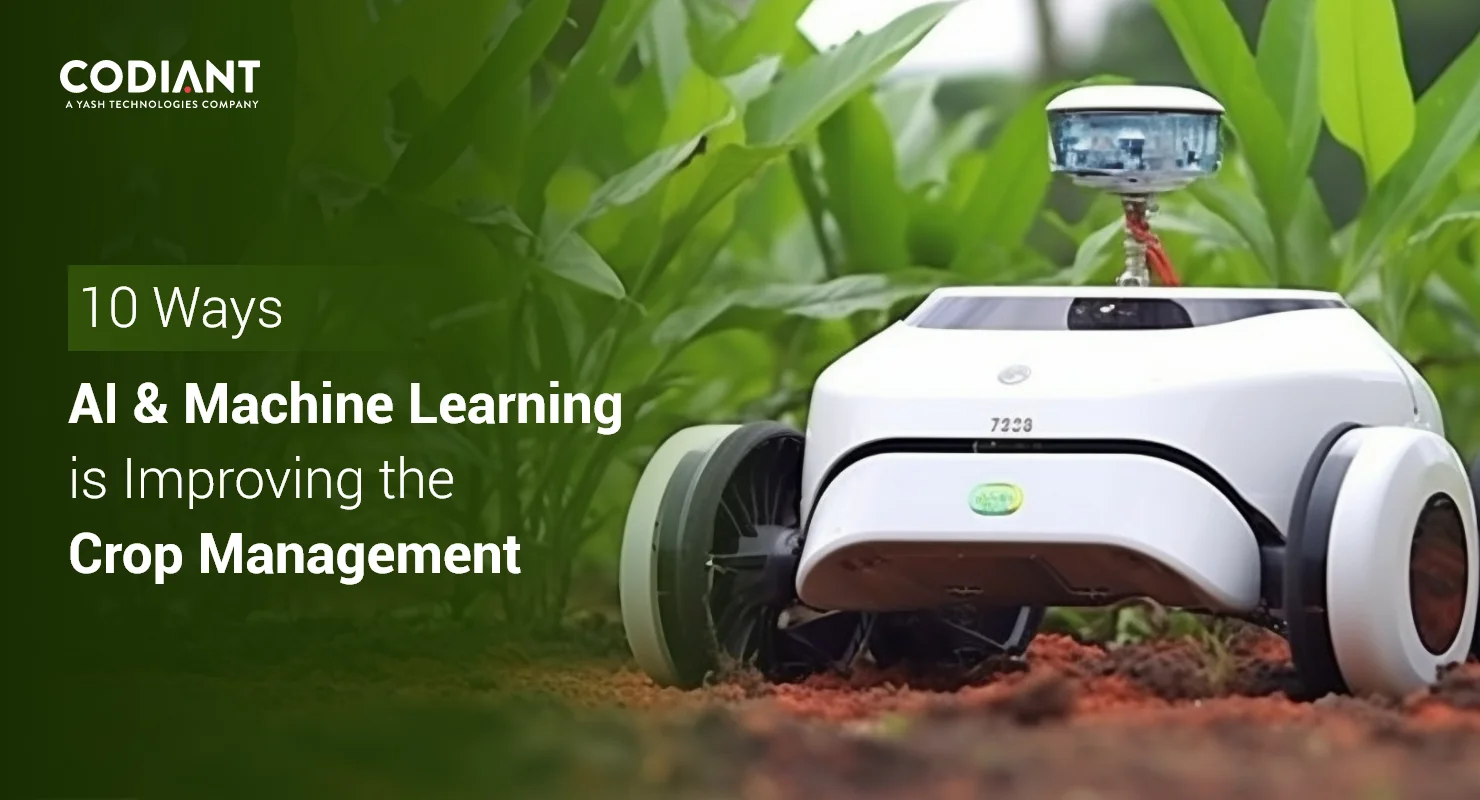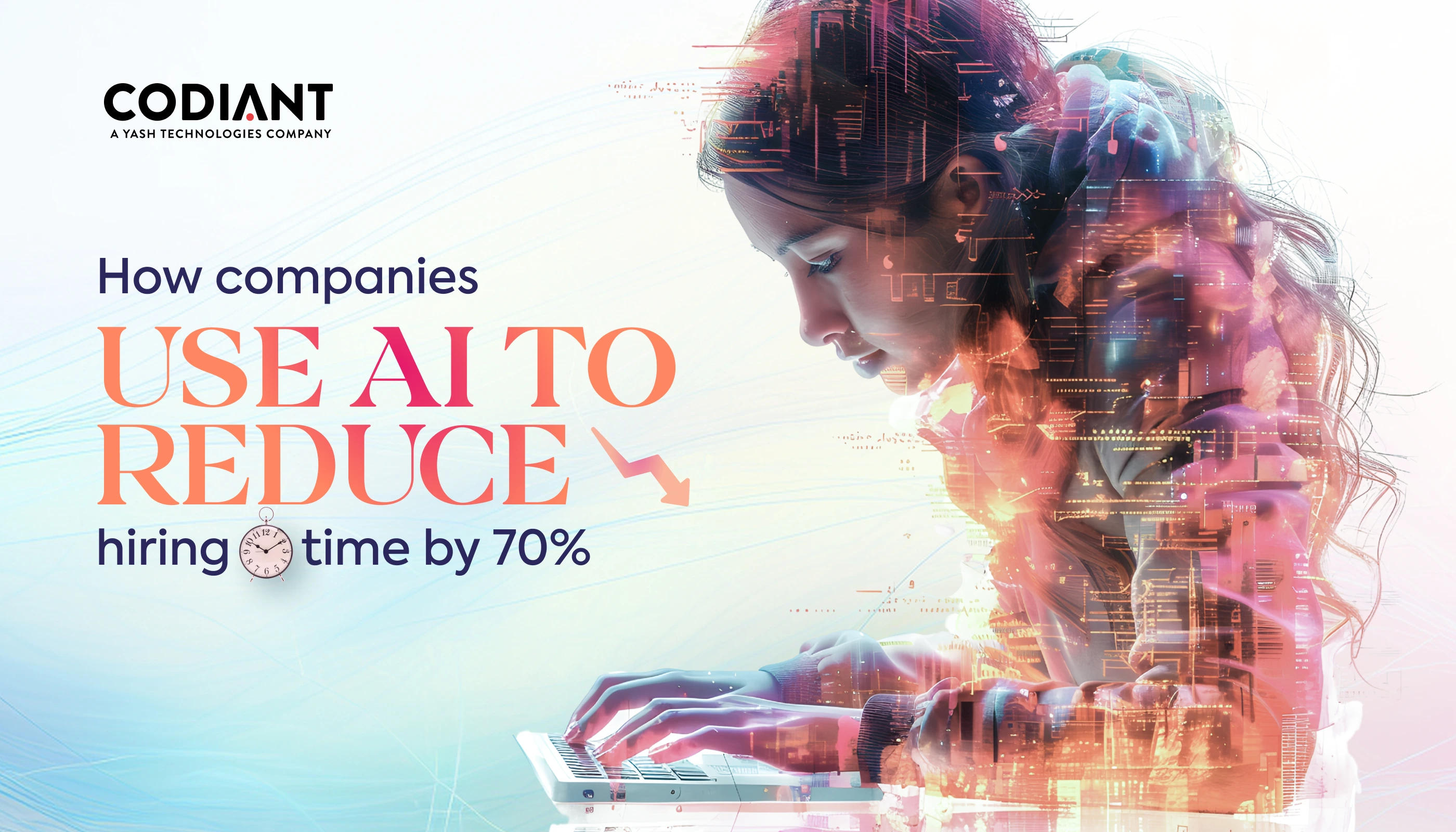10 Ways AI & Machine Learning Is Improving the Crop Management
Table of Contents
Subscribe To Our Newsletter

Agricultural advancement today is as important as technological growth because it is the source of feeding the huge population residing all around. Today, every farmer needs expert skills in using fertilizers, insecticides, soil maintenance, planting, irrigation, etc. to ensure a successful crop cycle. But, how is it possible to manage everything manually? AI/ML advancements will become the helping hand of farmers. With the use of smart AI/ML, and IoT-based sensors, farmers can precisely monitor the environmental conditions for better crop management and improving crop management through AI & Machine Learning.
Embracing the hi-tech equipment will prolong the overall lifespan of the crops and contribute to increasing yields, optimizing resources, and minimizing poor environmental impact.
The major technologies transforming the agricultural sector include detecting plant & insect disease, monitoring livestock health, automatic weeding, smart monitoring of crops & soil, and more. Later in this blog, you’ll read about the top 10 ways of improving crop management through AI/ML-based tools and techniques. Continue reading.
How AI & Machine Learning Improving Crop Management in 2023
AI and ML technologies enhance surveillance with smart drones, robots for precision farming, forecasting crop prices, trace and track systems, livestock health monitoring, irrigation optimization, pest management, and yield mapping analysis. These advancements optimize resources, minimize environmental impact, and ensure sustainable.
AI & Machine Learning Based Surveillance System
Manually managing crops and securing them from human or animal breach is quite difficult for the farmers or landlords. AI & machine learning for soil and crop management have fuelled with advancement by giving potential to protect their fields and buildings’ parameters.
Using the video surveillance system, owners get an immediate alarm if any animal destroys the crops accidentally.
Or if anyone feels any burglary at the remote farm location. Farm surveillance has gained huge popularity in the market with its effective process of optimizing crops, securing remote facilities, and preventing trespassers from checking the employees who work onsite and that’s a way of improving crop management through AI/ML, build your own crop management app.

Installing smart Drones
Improving crop-yield predictions is really simple using the data through real-time sensors and visual analytics data through drones. Agricultural experts can gain access to a high level of agricultural data that helps in enhancing their yield. Landowners easily get real-time data to understand the growth patterns of the crop over time by combining inground sensor data of fertilizer, moisture, and natural nutrient levels.
Precision farming is one of the best advantages of AI-based drones which can help in analyzing the condition of the soil and crop to enable targeted interventions like pesticide application and precise fertilizer. Moreover, drones can cover large areas quickly which ultimately minimizes operational and manual labor costs.
Use of Smart Tractors, Robotics and Agribots
Many a times, farmers face a shortage of workers which ultimately generates an immediate need for robotics, smart tractors, and robots. Many agricultural operations today are operated by robotics with b security measures around the perimeter of the agricultural land. Technological advancement in agriculture is helping farmers in improving their yields and cutting down costs.
The installation of self-propelled robots that distribute fertilizers on each row of crops is helping them do so. Using such smart options, farmers can serve to the diverse sizes of farms. This promotes productive farming practices and sustainability while minimizing the environmental impact.

Forecasting Price for Crops
Using an AI/ML-based system, prices of the crops can be easily forecasted which helps agricultural firms, farmers, and co-ops to negotiate the best prices for their individual harvests.
The overall demand curve of the crops will let you determine the price strategy based on the price elasticity curve i.e. unitary, inelastic, or highly elastic. Using such data, businesses in the agricultural industry can save a huge amount of data.
A Trace and Track System
The trace and track system are adopted across all the major supply chains which helps in offering greater visibility and control on the agricultural supply chain to reduce any inventory shrinkage.
The system easily helps in differentiating between inbounds’ shipment lots, batches, and container-level assignment of materials. Majorly, the IoT and RFID sensors are being used across most of the manufacturing units. Such sensors provide greater knowledge of the shipment’s conditions and ensure streamlined distribution and improved efficiency over manual processes.
Monitoring Livestock’s Health Using AI & ML
AI & ML based systems are widely used in monitoring livestock’s health which help in understanding the plant response to the diet and boarding conditions. Getting such minor information about the crops helps in managing them in the long run.
For example, understanding the cow’s daily intake and what keeps them happy is necessary for more milk production. Most of the farms today, who are relying on the daily livestock or daily milk produce can get excellent insights into how farms can be managed and can become more profitable in the long run.
AI/ML-based farm irrigation optimization system
Water is the major source of any agricultural growth and also the scarcest resource in many parts of the globe. So, ensuring irrigation efficiency by maintaining the required amount of water is essential to assure long-term profitability.
AI/ML-based system helps in understanding how the overall crop yields are improved by frequent crop irrigation. Most farmers use linear programming to calculate the sufficient amount of water needed to reach the expected level of yield. If you need to ensure that fields and crops are getting enough water without wasting, supervised machine algorithms are used widely.
Intelligent sensors to ensure use of the right mix of pesticides
Farmers now make use of these smart sensors that help in detecting the most infected areas of the plants. Using this smart application, it becomes easy to ensure that the right mix of biodegradable pesticides is used in required areas.
The supervised learnings used in these irrigation fields smartly define the optimal mix of pesticides to confirm that pests’ threat is not spreading further and also helping healthy crops from getting affected.
Enhance pest management with in-ground sensors
Pest management is one of the significant tasks in farming which can be done using in-ground sensors combined with drone data.
These AI/ML-based smart devices will help in monitoring the health level of the plant in order to predict the pest infestation before it actually occurs. For example, the United Nations is using smart sensors in collaboration with PwC to assess data on palm orchids situated in Asia. This will help in finding out the pest infestation and the trail of other significant actions.
Yield mapping analysis using ML algorithms
Today, experts are able to find out the exact potential level of the soil before the actual yield of the agricultural land gets started. The use of Machine learning algorithms helps in analyzing the social condition data from sensors, 3D mapping, drone-based data of the color of soil, and more.
The agricultural land is measured in flights to offer the most accurate data on the agricultural field and its yield capacity. However, adopting any technological advancement is not a child’s play.
List of challenges that farmers can face while embracing technology.
Heavy Upfront costs
We are aware of the fact that technology advancement will be beneficial in the long run but initial investment will definitely be expensive. There is a list of agribusinesses struggling financially and it will be next to impossible for them to adopt such advancements. But, still, businesses can look for better opportunities in getting funds from private investors or from any government grants.
Lengthy process of technology adoption
Generally, agribusinesses those who are currently using technologies also lack the required level of infrastructure needed to grow which is one of the biggest challenges in this industry. To overcome such challenges one can, adopt the simplest technologies initially and then grow gradually. Once farmers are familiar with current tech advancements then, adopting better tools and technologies will not be a challenging task to perform.
Low practical exposure using new technologies
Every region has some capabilities for technology adoption across the world. In comparison, a few of the areas may excel in leveraging the tech advancements but in some areas, it would be a tiring task. So, just to eradicate such hurdles, economies can take proactive measures. They can offer robust training and support for farmers and agribusiness owners to take innovative solutions.
Privacy & security issues
Every technology comes with some privacy and security issues and legal questions. For instance, any data leakage or cyberattacks in any of the tech-based agricultural tools may cause serious issues for the farmers. Even, any cyber attackers may especially target the AI/ML-based farming system to stop the food supply or lower the economy of any region.
Summing Up!
Humans in every field have revolutionized with the adoption of advanced technology and so is the case of agriculture. Technology has been a part of improving agricultural efficiency for so long but now, it is becoming more important than ever. AI/ML has got strong ability to bring significant changes in certain areas including:
- Better environmental sustainability
- Increased labor, resources, and time efficiency
- Access to real-time monitoring in promoting greater health & quality produce
- Making smarter resource allocation etc.
The list of significant changes using AI/ML in the field of agriculture is endless. So, get ready to enter a whole new phase of experiencing agricultural evolution. Thanks to AI/ML and other advanced tech enhancements.
Frequently Asked Questions
Biodegradable insecticides can be applied precisely when smart sensors identify plant diseased areas. By optimizing the combination, supervised learning stops pests from spreading.
Challenges include high upfront expenditures, a protracted adoption process, little exposure to new technology in real-world settings, and worries about security and privacy implications related to data usage.
AI/ML-based systems monitor livestock health, providing insights into dietary responses and boarding conditions. This information helps in effective farm management.
In order to accurately estimate the potential output of agricultural land and support resource planning, machine learning algorithms evaluate data from drones, 3D mapping, and soil conditions.
AI/ML is revolutionizing agriculture in a way that improves productivity, promoting environmental sustainability, increasing efficiency, providing real-time monitoring, and makes it possible to allocate resources more wisely.
Featured Blogs
Read our thoughts and insights on the latest tech and business trends
How a Voice AI Agent Can Help You Get More Appointments and Leads
- November 17, 2025
- Artificial Intelligence
Missed calls, delayed responses, and lost leads are silent revenue killers for many businesses. In today’s fast-moving market, customers expect instant engagement - and that’s exactly where a voice AI agent for appointment booking steps... Read more
How to Integrate AI in Recruitment and Cut Hiring Time by 70%
- November 13, 2025
- Artificial Intelligence
Recruiting teams face a clear operational challenge: too much manual work and not enough qualified talent reaching the finish line. Even with modern ATS systems, most hiring workflows still depend on human-driven screening, coordination, and... Read more
How to Build AI Agents That Can Speed Up Your Work and Reduce Other Expenses
- November 10, 2025
- Artificial Intelligence
Businesses today are looking for faster ways to work and smarter tools that cut costs. That’s why AI agents are quickly becoming a key investment for companies of all sizes. These autonomous systems can perform... Read more




